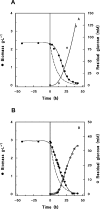Carbonic anhydrase (Nce103p): an essential biosynthetic enzyme for growth of Saccharomyces cerevisiae at atmospheric carbon dioxide pressure
- PMID: 15948716
- PMCID: PMC1276929
- DOI: 10.1042/BJ20050556
Carbonic anhydrase (Nce103p): an essential biosynthetic enzyme for growth of Saccharomyces cerevisiae at atmospheric carbon dioxide pressure
Abstract
The NCE103 gene of the yeast Saccharomyces cerevisiae encodes a CA (carbonic anhydrase) that catalyses the interconversion of CO2 and bicarbonate. It has previously been reported that nce103 null mutants require elevated CO2 concentrations for growth in batch cultures. To discriminate between 'sparking' effects of CO2 and a CO2 requirement for steady-state fermentative growth, we switched glucose-limited anaerobic chemostat cultures of an nce103 null mutant from sparging with pure CO2 to sparging with nitrogen gas. This switch resulted in wash-out of the biomass, demonstrating that elevated CO2 concentrations are required even under conditions where CO2 is produced at high rates by fermentative sugar metabolism. Nutritional analysis of the nce103 null mutant demonstrated that growth on glucose under a non-CO2-enriched nitrogen atmosphere was possible when the culture medium was provided with L-aspartate, fatty acids, uracil and L-argininine. Thus the main physiological role of CA during growth of S. cerevisiae on glucose-ammonium salts media is the provision of inorganic carbon for the bicarbonate-dependent carboxylation reactions catalysed by pyruvate carboxylase, acetyl-CoA carboxylase and CPSase (carbamoyl-phosphate synthetase). To our knowledge, the present study represents the first full determination of the nutritional requirements of a CA-negative organism to date.
Figures



References
-
- Jones R. P., Greenfield P. F. Effect of carbon dioxide on yeast growth and fermentation. Enzyme Microb. Technol. 1982;4:210–223.
-
- Tripp B. C., Smith K., Ferry J. G. Carbonic anhydrase: new insights for an ancient enzyme. J. Biol. Chem. 2001;276:48615–48618. - PubMed
-
- Dodgson S. J. New York: Plenum Press; 1991. The Carbonic Anhydrases; Cellular Physiology and Molecular Genetics.
Publication types
MeSH terms
Substances
LinkOut - more resources
Full Text Sources
Other Literature Sources
Molecular Biology Databases

